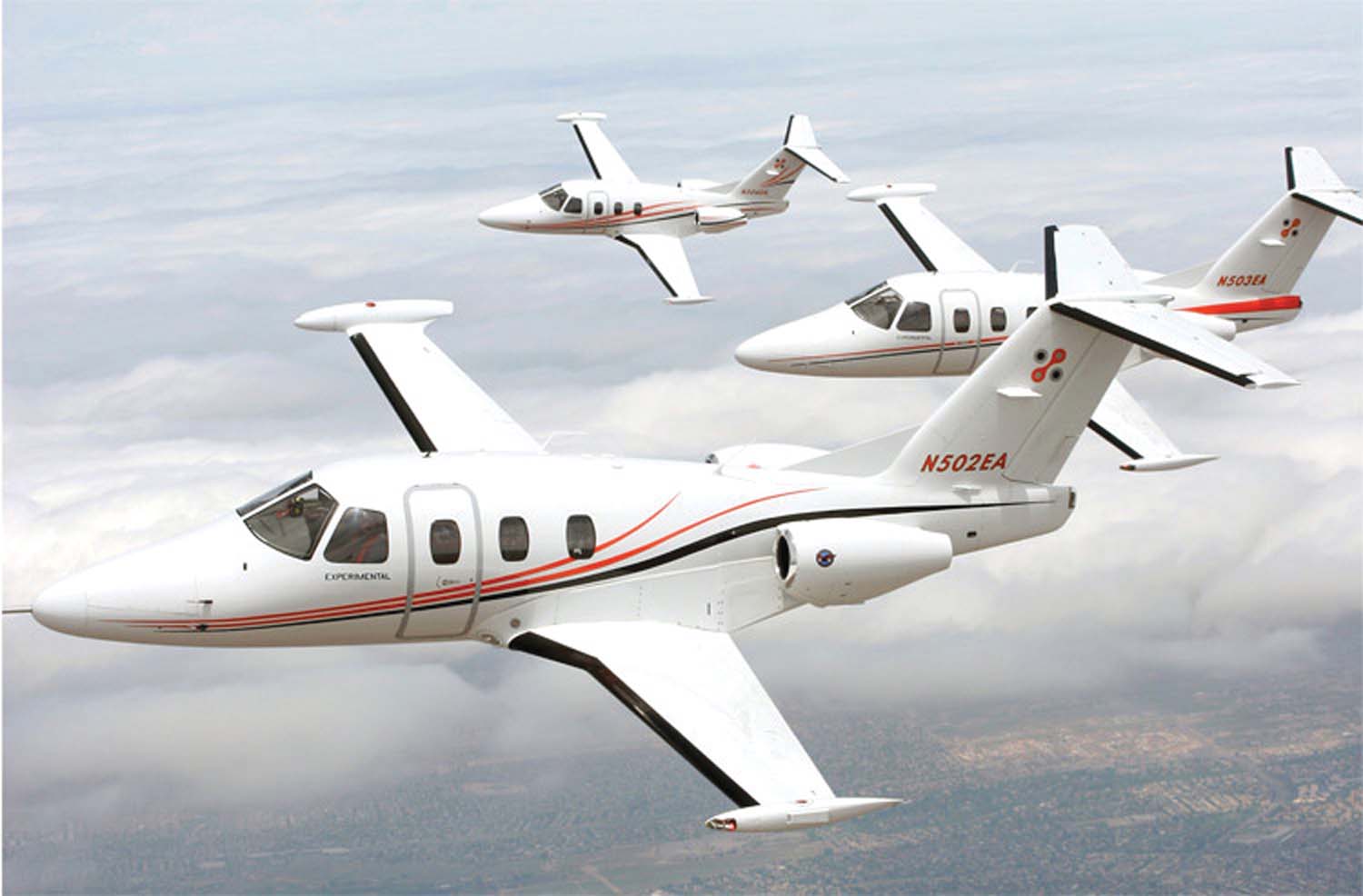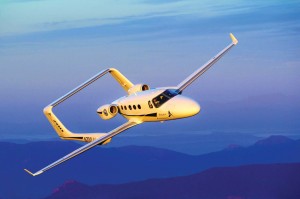Photo By Jeff Mattoon
Lance Armstrong was successful in his attempt to win the Tour de France a historic seventh time. What, you might ask, does a bicycle race have to do with aviation? Since VLJs have been compared to all sorts of automobiles by many aviation writers, including this one, it felt a bit trite to once again compare the rush to VLJ certification to an Indy or NASCAR race, so for this month, it’s bicycles.
The race, if you want to call it one, is on. And like the big race through the French countryside, it’s more a multi-day (read multi-year) contest with starts and fits, jubilations and disappointments. At this moment there are only a handful of companies racing; others are still in Paris sipping red wine by the Seine, while a few are still in the shop designing their bikes, many of whom are wondering if they’ll ever start. Oh, none of them will tell you that out loud, but you suspect that’s what they’re thinking.
Safire Jet
A case in point is Safire Aircraft. Actually, we don’t know what CEO Camilo Salomon is thinking because the only quote we could gather is, “We’re sorry, the number you have reached is disconnected or is no longer in service…” The final entry on their website was dated June 10, 2004, announcing the company had “temporarily suspended most operations.”
Additionally, according to published reports, Safire was evicted from its building at Opa-locka Airport near Miami a month later. The last words from Salomon were, equivocally, “We’ll be back.” They’re not only not back, but it looks as though all of their reported depositors were siphoned off by other VLJ manufacturers. Safire: non-starter.
Diamond D-Jet
Austrian/Canadian Diamond Aircraft’s D-JET isn’t racing or sipping the wine. The D-JET appears to still be on the drawing board. The single-engine, all composite fuselage aircraft is, however, making progress.
The company recently announced their selection of the Garmin G1000 as the avionics suite of choice for their entry.
“The G1000 was the logical choice for the D-JET. Apart from the system being top quality in features, performance and upgradeability, we like the cockpit commonality with our piston aircraft, and Garmin’s strength in GA avionics systems,” said CEO Christian Dries.
This was a natural choice for Diamond since the G1000 is already utilized in the DA40-180 Diamond Star and the DA42 Twin Star.
The company had previously announced the selection of the Williams FJ-33-4 as the powerplant of choice. According to company sources, first flight is expected in late 2005, with initial deliveries expected sometime in 2007.
Embraer
The latest entrant into the very light jet category is Embraer, the Brazilian aircraft manufacturer, builder of a whole host of not-very-light aircraft.
Since the fall of last year, Embraer has done a mediocre job of convincing the public they were not developing a VLJ project. Okay, they were leveling with us—they were developing a very light jet and a light jet.
In their press conference held in early May, the company announced two new models, currently named simply “The Light Jet” and “The Very Light Jet”—creative.
The company has a lot of catching up to do, but due to the success of its commercial, business-class and military fleet, and since it is one of the top two exporting companies in Brazil, Embraer must be taken seriously.
And then there were four.
That leaves four companies who have not only created proofs of concepts, but have actually created aircraft that roll under their own power, conducted testing and have actually taken deposits. Eclipse Aviation’s Eclipse 500, Cessna’s Citation Mustang, Adam Aircraft’s A700 and ATG’s Javelin.
Eclipse 500
Vern Raburn said a long time ago (in VLJ years) that he wasn’t building an airplane; he was building a company—and that’s what he’s done.
The Eclipse 500 is a six-place aircraft with twin Pratt & Whitney Canada PW610F engines pushing at 900 pounds each. Exclusive to the Eclipse is the Avio Total Aircraft Integration avionics systems working cooperatively with Avidyne avionics.
Avio offers integrated avionics functionality for communications, navigation, situational awareness and flight guidance and control. Eclipse says, “Integration reduces the number of boxes and control heads necessary to manage the aircraft, thereby reducing weight and pilot workload.”
With the third conforming Eclipse 500 in the air and with numbers four and five soon following, it appears nothing, except of course, the Federal Aviation Administration, can stop the company now. To date, total flight time for all test aircraft surpasses one hundred hours, and the company expects certification in first quarter 2006.
Mustang

The Cessna Citation Mustang departs from McConnell Air Force Base in Wichita, Kansas, on April 23, 2005 for its successful first flight.
Aviation giant Cessna Aircraft Company announced its VLJ entry back in 2002 and has worked steadily at creating its new Citation model, the Mustang, with twin Pratt & Whitney Canada PW615F engines offering takeoff thrust 1,350 pounds each. The six-place Mustang has a fine pedigree in the success of the Citation line of jet aircraft dating back to 1968, and it was no surprise Cessna was among the first to enter the race.
The Garmin G1000 avionics suite has received the nod and first flight of the first prototype occurred in April.
“The Citation Mustang is getting off to a great start,” said Jack J. Pelton, Cessna’s chairman, president and CEO. “We were able to complete first flight ahead of schedule, and during the first two weeks of flight testing we have not lost any flights due to mechanical or system failures.”
The Mustang isn’t without its critics who believe the approximate 8,000 pound takeoff weight and the nearly $2.5 million price tag places it on the fringe of the VLJ market.
A700
Adam Aircraft is taking an interesting approach to the creation of their Adam A700; they’re actually creating two airplanes. The first is a twin, in-line piston aircraft, the A500, and the twin Williams FJ-33 A700 VLJ. Why? Bigger bang for the buck.
The A500, which was certified in May, offers more than 60 percent of its certified parts to the A700, thereby drastically reducing approval time. Brilliant.
Ostensibly, the A500 will be the perfect trainer for the A700. In fact, the company offers the purchaser of an A700 an insurance guarantee—if they purchase and accumulate a minimum number of hours in the A500. Brilliant.
The A700 boasts the largest cabin among current VLJ leaders. So large, in fact, that it includes an aft lavatory—which may become a huge factor if the air-taxi industry develops.
First flight of the A700 occurred long ago—the aviation world was surprised when it showed up at Oshkosh in 2003—under its own power. However, only time will tell if the decision by Rick Adam to utilize a nearly 100 percent composite airframe and wings is the correct approach. The company is quick to point to examples set by Boeing, Airbus and Cirrus, stating that carbon fiber and other composites are the wave of the future.
Certification of the A700 is expected in the second quarter of 2006.
Javelin
There’s one race entrant who really believes they’re in a different race altogether. Nearly everyone who sees the Aviation Technology Group, Inc. Javelin for the first time can’t believe what they see. Is it a VLJ? Is it a military trainer? Is it an aerobatic gem? Actually it’s all of those things.
The Javelin is a twin turbofan, two-place VLJ. It’s powered by specially modified Williams FJ33-4-15M turbofan engines, which include an inverted oil system to allow for aerobatic flight. ATG founder and CEO George Bye’s vision of the Javelin was to create a super high performance general aviation aircraft that would have an alter ego as a military trainer—and he’s done it. Well, almost.
At press time the ATG test team has conducted taxi tests on the Javelin and first flight was days away, according to ATG Communications Manager Sara Newton. Company COO and President Charlie Johnson says that right now there are delays, but only those typical to this phase of building a new aircraft.
“The team at ATG is focused on building the Javelin and hitting our milestones,” Johnson says. “These are some very exciting times for us.”
Minor delays and all, the company is ecstatic. Firm orders for the Javelin have far exceeded business plan projections.
And who is that?
But wait, there appears to be a new contender that might be farther along than anyone expected—Bob Bornhofen’s much forgotten about Sport-Jet.
While new industry leaders are building corporations with hundreds of employees and spending in the high tens and hundreds of millions of dollars for development of their aircraft, Bob Bornhofen’s Excel-Jet company has a staff of three and he’s spent far less than any VLJ manufacturer who has an aircraft ready to fly.
The Sport-Jet is a four-place, composite airframe and wing, single-engine VLJ. Originally the Sport-Jet was to utilize aluminum wing members, but a serious setback occurred with a supplier. Undaunted, aeronautical engineer Bornhofen decided to make a change moving to the carbon fiber versions manufactured in Colorado.
On July 15, Bornhofen and the Excel-Jet staff unveiled the Sport-Jet to the public. The aircraft exterior appears ready to go, but the prototype’s interior was clearly not a finished product. According to Bornhofen, engine and avionics systems are all installed and nearly ready for a first flight in Colorado Springs sometime within the next couple of weeks.
The finish line.
Who will wear the yellow jersey and fly around the Champs-Elysées? No one really knows, and if you want the truth, it doesn’t really matter.
So far, it seems the latter manufacturers are going to make it. They will succeed in creating a new industry that many (very many) pundits doubted would ever come to pass.
In the beginning the doubters seemed correct. Many manufacturers predicted a 2004 certification date and nobody made it. Nearly all revised their dates to 2006—and be sure, if that year comes and goes with no VLJ certification, it will be difficult for many to find additional funding, not to mention customers..
At this point, that all seems moot because at least two of the above manufacturers seem real close to certification. We’ll see.
To all who are in the race and all who dare to follow, bonne chance!













